译林版(2019)必修第二册Unit 1 Lights, Camera, Action! Grammar and usage课件(共39张PPT)
文档属性
| 名称 | 译林版(2019)必修第二册Unit 1 Lights, Camera, Action! Grammar and usage课件(共39张PPT) |  | |
| 格式 | pptx | ||
| 文件大小 | 1.2MB | ||
| 资源类型 | 教案 | ||
| 版本资源 | 牛津译林版(2019) | ||
| 科目 | 英语 | ||
| 更新时间 | 2023-12-25 12:17:59 | ||
图片预览

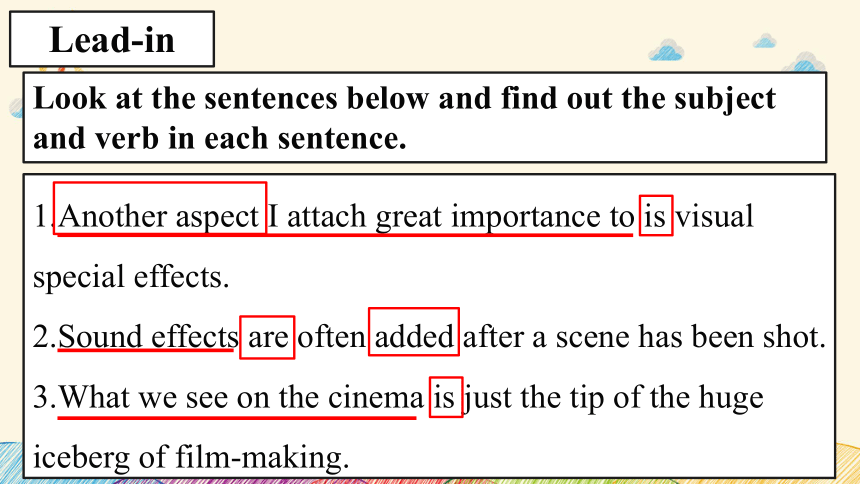
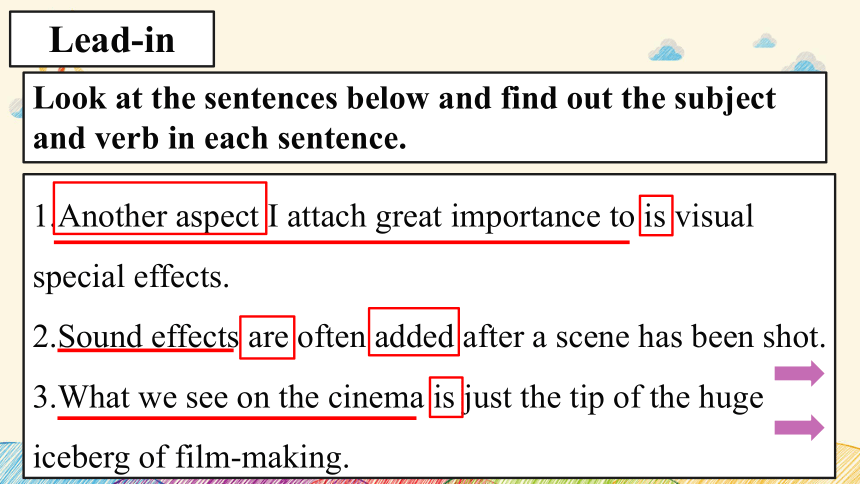

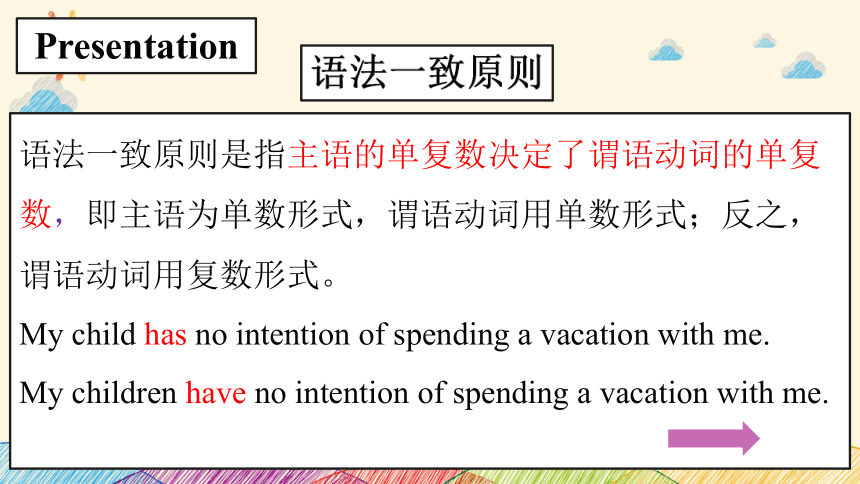
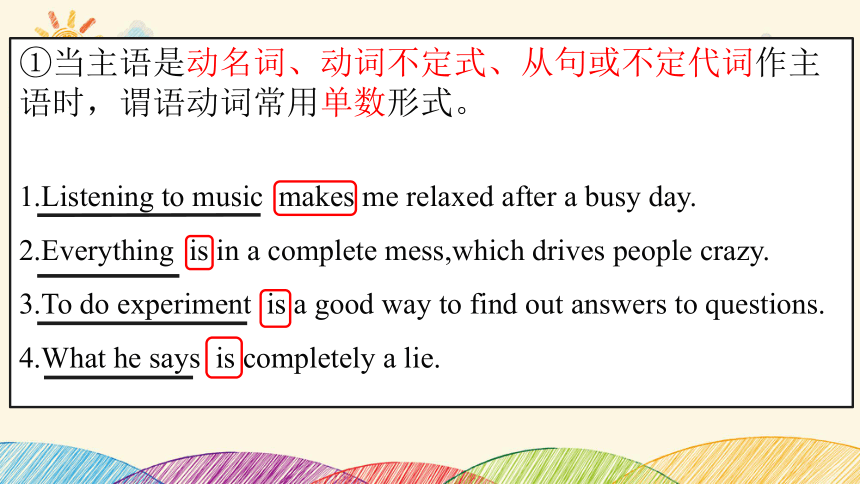
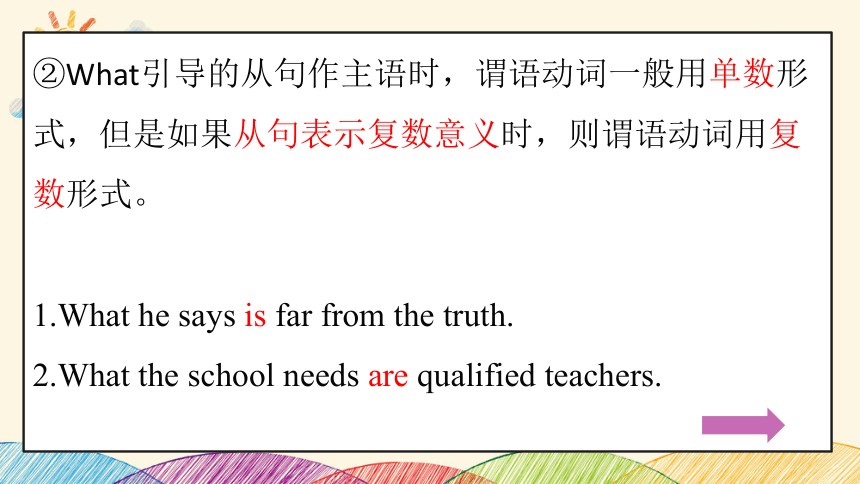
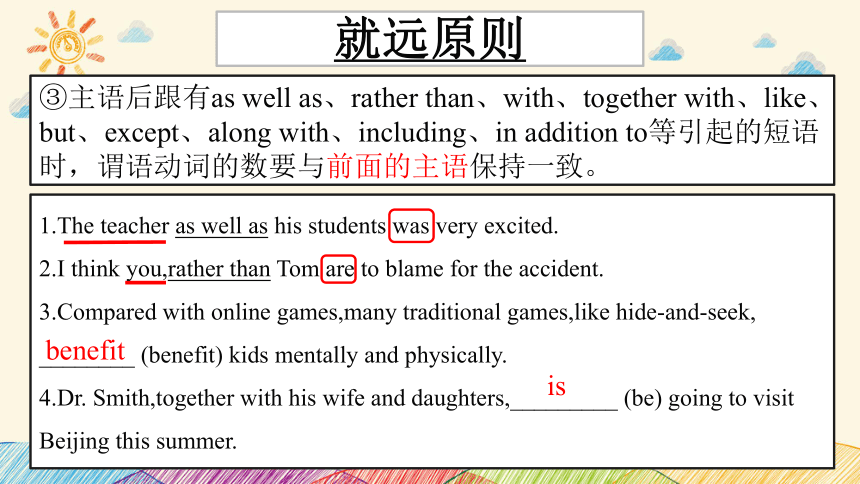

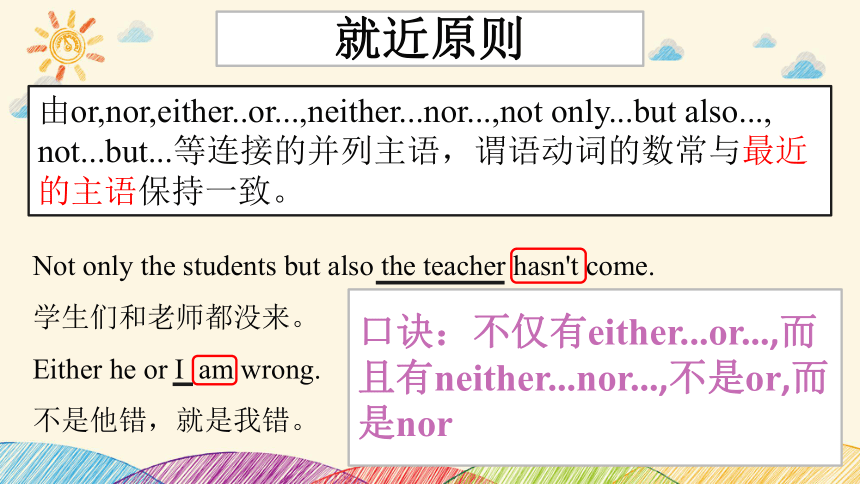
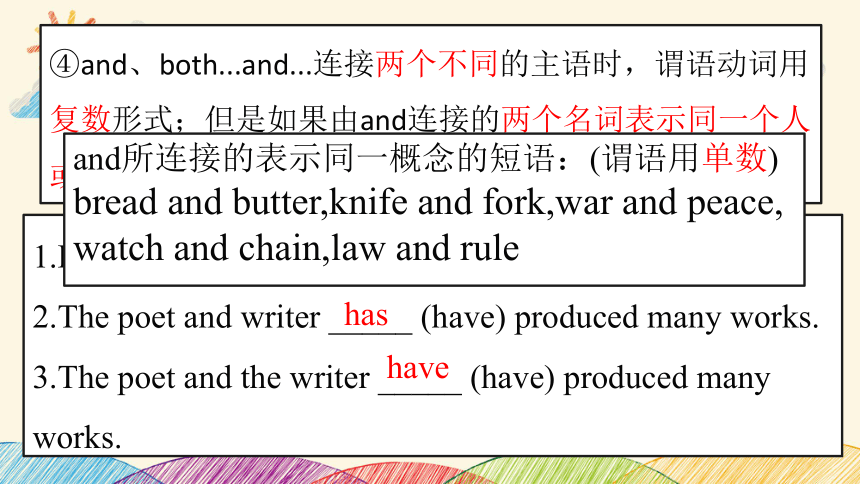
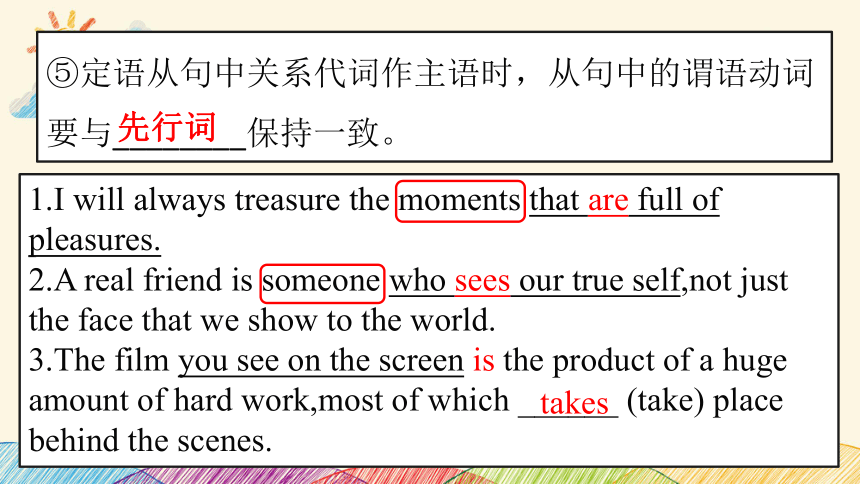
文档简介
(共39张PPT)
Unit 1 Lights,camera,action!
Grammar and Usage
Look at the sentences below and find out the subject and verb in each sentence.
Lead-in
1.Another aspect I attach great importance to is visual special effects.
2.Sound effects are often added after a scene has been shot.
3.What we see on the cinema is just the tip of the huge iceberg of film-making.
Look at the sentences below and find out the subject and verb in each sentence.
Lead-in
1.Another aspect I attach great importance to is visual special effects.
2.Sound effects are often added after a scene has been shot.
3.What we see on the cinema is just the tip of the huge iceberg of film-making.
所谓主谓一致就是指在句子中,谓语动词必须在“人称”和“数”上与主语保持一致。主谓一致涉及三个基本原则,即语法一致原则、意义一致原则和就近一致原则。
Subject-verb agreement
主谓一致
语法一致原则是指主语的单复数决定了谓语动词的单复数,即主语为单数形式,谓语动词用单数形式;反之,谓语动词用复数形式。
My child has no intention of spending a vacation with me.
My children have no intention of spending a vacation with me.
语法一致原则
Presentation
①当主语是动名词、动词不定式、从句或不定代词作主语时,谓语动词常用单数形式。
1.Listening to music makes me relaxed after a busy day.
2.Everything is in a complete mess,which drives people crazy.
3.To do experiment is a good way to find out answers to questions.
4.What he says is completely a lie.
②What引导的从句作主语时,谓语动词一般用单数形式,但是如果从句表示复数意义时,则谓语动词用复数形式。
1.What he says is far from the truth.
2.What the school needs are qualified teachers.
③主语后跟有as well as、rather than、with、together with、like、but、except、along with、including、in addition to等引起的短语时,谓语动词的数要与前面的主语保持一致。
1.The teacher as well as his students was very excited.
2.I think you,rather than Tom are to blame for the accident.
3.Compared with online games,many traditional games,like hide-and-seek, ________ (benefit) kids mentally and physically.
4.Dr. Smith,together with his wife and daughters,_________ (be) going to visit Beijing this summer.
就远原则
benefit
is
就远原则
四除:but,except,in addition to,
五和:with,along with,together with,as well as,
好像:like
包括:including
而不是:rather than,
不少于,多达:no less than
口诀:四除五和好像包括而不是强调多
besides
combined with
instead of
Not only the students but also the teacher hasn't come.
学生们和老师都没来。
Either he or I am wrong.
不是他错,就是我错。
由or,nor,either..or...,neither...nor...,not only...but also..., not...but...等连接的并列主语,谓语动词的数常与最近的主语保持一致。
口诀:不仅有either...or...,而且有neither...nor...,不是or,而是nor
就近原则
④and、both...and...连接两个不同的主语时,谓语动词用复数形式;但是如果由and连接的两个名词表示同一个人或物时,谓语动词用单数形式。
1.Her teacher and her friends are in the sitting room.
2.The poet and writer _____ (have) produced many works.
3.The poet and the writer _____ (have) produced many works.
and所连接的表示同一概念的短语:(谓语用单数)
bread and butter,knife and fork,war and peace, watch and chain,law and rule
has
have
⑤定语从句中关系代词作主语时,从句中的谓语动词要与________保持一致。
1.I will always treasure the moments that are full of pleasures.
2.A real friend is someone who sees our true self,not just the face that we show to the world.
3.The film you see on the screen is the product of a huge amount of hard work,most of which ______ (take) place behind the scenes.
先行词
takes
⑥“Many a/more than one + 单数名词”作主语时,谓语动词用单数形式;each、every、no所修饰的名词作主语时,即使有and连接,谓语动词仍用单数形式。
1.Many a parent has had to go through this same painful process.
2.Each boy and girl wants to be slim and energetic.
3.Every boy and every girl,together with some teachers who are to visit the museum,____(be) asked to be at the school gate before 6:00 in the morning.
is
2.意义一致原则
意义一致原则是指不管主语的形式是单数还是复数,主语的意义决定了谓语动词的单复数。
The class consists of 25 boys and 20 girls.
The class are doing experiment.
①集体名词作主语时,若被看作一个整体,谓语动词用单数形式;若被看作是构成集体的一个个成员,谓语动词用复数形式。
常见的集体名词有:family,class,team,group,public,committee,government,audience,club,population,enemy,party,crowd,army,等
The whole family ___(be) watching Spring Festival Gala now.
部分集体名词只能看作复数作主语时,谓语用复数形式。
如:people, police, cattle, folk, personnel, crew等。
is
②“分数/百分数/the majority +of +名词”作主语时,谓语动词的单复数取决于of后名词的数以及其表示的意义;a lot of/lots of,plenty of,all of, some of, half of,most of,the rest等作主语时,谓语动词的单复数取决于名词的类别。
About one third of the books are worth reading.
Only 60 percent of the work was done yesterday.
All of this is wonderful,but the best part of this film is the acting.
The rest of the players are great and I couldn’t be happier.
1.About 50% of the land ______(be) suitable to grow plants.
2.Most of the money ________(have) been collected.
is
has
③“The + 形容词”表示一类人在句中作主语时,谓语动词用复数形式。
The old are taken care of here.
The rich own the robots,so they will be fine.
1.The poor _____(be) part of the people we help.
④quantity后既可以接不可数名词,也可以接可数名词复数,谓语动词的单复数取决于quantity单复数。还有主语由“...kind/sort/type/amount of +n.”构成,与此同理。
A quantity of time has been wasted on the project.
This kind of flower is most beautiful.
1.A quantity of story books _______(have) been bought for the children.
are
has
⑤“a number of +复数名词”作主语时,谓语动词用复数形式;
“the number of +复数名词”作主语时,谓语动词用单数形式。
A number of students have gone for an outing.
The number of the students is increasing year after year.
⑥表示时间、距离、重量、金额等复数名词作主语时,谓语动词通常用单数形式。
Three thousand dollars is quite a lot of money for a boy.
1.Twenty years _________(stand) for a long period in one’s life.
2.Six hundred miles ______ (be) a long distance.
1.The total number of the population in the country ____ (be) about 400 million.
is
is
stands
⑦以-s/-ics结尾的学科名词及news作主语时,谓语动词用单数形式。
No news is good news.
以-s/-ics结尾的学科名词: mathematics(maths/math),physics,politics
1.Surprisingly,maths _____(be) voted their favorite subject last week.
2.Both of us ______(be) fond of watching football games.
3.Physics ______(be) his favorite subject.
is
are
is
3.就近一致原则
就近一致原则是指当主语由两个或两个以上的名词或代词组成时,谓语动词与它紧邻的名词或代词在“人称”和“数”上保持一致。
There is a square table and some chairs in the centre of the dining room.
餐厅中央有一张方桌和几把椅子。
Either your students or William knows this.
不是你的学生就是威廉知道这件事。
Not only the students but also the teacher hasn't come.
学生们和老师都没来。
Either he or I am wrong.
不是他错,就是我错。
①由or,nor,either..or...,neither...nor...,not only...but also..., not...but...等连接的并列主语,谓语动词的数常与最近的主语保持一致。
口诀:不仅有either...or...,而且有neither...nor...,不是or,而是nor
There are three books and a pen on the desk.
There is a pen and three books on the desk.
Here ____ (be) pen,a few envelopes and some paper in the drawer.
②由there、here引起的主语不止一个是,谓语动词的数通常和最近的主语保持一致。
is
其他情况:
1.在“one of+复数名词或代词”作主语时,谓语动词用单数形式
One of the men doctors is visiting the patient.
2.定语从句中谓语动词的“人称”和“数”由先行词决定;若先行词是“one of+复数名词”,关系词作主语时,谓语动词用复数形式,若是“the (only/very/right) one of+复数名词”,用单数形式。
He is one of the students who come from England.
He is the only one of the boys in our class that speaks English well.
3.none of后接不可数名词时,谓语动词用单数形式;如果接复数名词,则谓语动词既可用单数,也可用复数。
None of my friends have/has arrived yet.
Summary
主谓一致
语法一致原则
1.当主语是动名词、动词不定式、从句或不定代词作主语时,谓语用______
2.What引导的从句作主语时,谓语一般用_________
3.主语后跟有with,along/together with,as well as,like,but, except, rather than等引起的短语时,谓语要与_____________保持一致
4.and、both...and...连接__________的主语时,谓语用复数形式;但如果and连接的两个名词表示_____________时,谓语动词用单数形式。
5.定语从句中关系代词作主语,从句的谓语要与________保持一致。
6.“Many a/more than one + 单数名词”作主语时,谓语用____形式;each、every、no所修饰的名词作主语时,即使有and连接,谓语动词用________形式。
就远原则
口诀:不仅有either...or...,而且有neither...nor...,不是or,而是nor(就近原则)
口诀:四除五和好像包括而不是强调多(就远原则)
单数
单数
前面的主语
两个不同
同一人或物
先行词
单数
单数
Summary
主谓一致
意义一致原则
1.当主语是集体名词,若看作整体,谓语用_____,若是看作部分,谓语用______
2.“分数/百分数/the majority +of +名词”作主语时,谓语取决于_____,a lot of/lots of,plenty of,all of, some of, half of,most of,the rest of等作主语时,与此同理
3.“The + 形容词”表示一类人,谓语用______
4.quantity/kind/sort/type of +n.谓语动词的单复数取决于_____
5.“a number of +复数名词”作主语时,谓语动词用________;
“the number of +复数名词”作主语时,谓语动词用________
6.表示时间、距离、重量、金额等复数名词作主语时,谓语动词通常用________
7.以-s/-ics结尾的学科名词及news作主语时,谓语用______
单数
复数
复数
单数
单数
单数
复数
of后的名词
quantity本身单复数
Summary
主谓一致
就近一致原则
1.口诀:不仅有either...or...,而且有neither...nor...,不是or,而是nor,谓语与_________的主语保持一致。
2.由there、here引起的主语不止一个是,谓语动词的数通常和__________主语保持一致
主谓一致
其他情况
1.“one of+复数名词或代词”作主语时,谓语用________
2.定语从句中先行词是“one of+复数名词”,关系词作主语时,谓语动词用__________
none of后接不可数名词时,谓语动词用单数形式;如果接复数名词,则谓语动词既可用单数,也可用复数。
最近
最近的
单数
复数
1.可数名词单数或不可数名词作主语时
2.从句、不定代词、不定式和动名词作主语时
3.“Many a/more than one + 单数名词”作主语时;
each、every、no所修饰的名词作主语时,即使有and连接
4.表示时间、距离、重量、金额等复数名词作主语时
5.以-s/-ics结尾的学科名词及news作主语时
6.“the number of +名词复数”作主语时
7.由and连接的两个名词表示同一个人或物时
8.在“one of+复数名词或代词”作主语时
9.none of后接不可数名词时作主语时;如果接复数名词,则谓语动词既可用单数,也可用复数
谓语动词常用单数形式的情况
1.可数名词复数作主语时
2.具有复数意义的集体名词如people,police,cattle,crew,folk, personnel等作主语时
3.“The + 形容词”表示一类人在句中作主语时;
4.and、both...and...连接两个不同的主语时
5.quantities of/a group of/a number of +名词复数作主语时
6.“kinds/sorts/types of +n.”作主语时
谓语动词常用复数形式的情况
1.What引导的从句作主语时,谓语动词一般用单数形式,但是如果从句表示复数意义时,则谓语动词用复数形式
2.主语后跟有with、together with、as well as、like、but、except、along with、rather than(instead of)、including、in addition to等引起的短语时,谓语动词的数要与前面的主语保持一致(就远原则)
3.定语从句中关系代词作主语时,从句中谓语动词的“人称”和“数”由先行词决定;若先行词是“one of+复数名词”,关系词作主语时,谓语动词用复数形式,若是“the only one of+复数名词”,用单数形式。
谓语动词视情况而定
4.集体名词如family, class, team, group, public, committee,audience, government,club,population,enemy,party,crowd,army等作主语时,强调是整体时,谓语用单数,强调时部分的成员,谓语用复数
5.“分数/百分数/the majority +of +名词”或“all of, some of, half of, most of,the rest of+名词”作主语时,取决于后接的名词类别
6.由or,nor,either..or...,neither...nor...,not only...but also...,not...but...等连接的并列主语,谓语动词的数常与最近的主语保持一致(就近原则)
谓语动词视情况而定
7.定语从句中谓语动词的“人称”和“数”由先行词决定;若先行词是“one of+复数名词”,关系词作主语时,谓语动词用复数形式,若是“the only one of+复数名词”,用单数形式。
谓语动词视情况而定
1. More than one picture _______(show) that over 70% of the island ____ (be) covered by water.
2. Large amounts of money _____(be) spent on the magnificent building,but the poor ______(be) not allowed to have a single room.
3. I,who ____ (be) your best friend,will surely stand on your side.
4. Most of the artists will go to Shenzhen next week.The rest _____(be) to visit Hongkong.
5. Every boy and every girl,together with some teachers who ______(be) to visit the museum,____(be) asked to be at the school gate before 6:00 in the morning.
shows
were
were
am
are
is
are
is
amount修饰不可数名词
a large amount of +不可数n.,谓语动词用单数
large amounts of +不可数n.,谓语动词用复数
6.Going out to the bar and drinking _____(be) a way to relax, but not good for your health at all.
7.A smile and handshake _______ (show) welcome.
8.Frank,with his two sisters,_____________(leave) London by train next morning.
9.Mr. Smith as well as his wife and daughter _____(be) going to the Great Wall next week.
10.Two fifths of the land in that district _____(be) covered with trees and grass.
is
shows
is leaving
is
is
11.The whole family _____________(watch) Spring Festival Gala now.
12.The drunken driver,rather than the passers-by ____(be) to blame for the traffic accident.
13.Barbara is easy to recognize as she’s the only one of the women who _______(wear) evening dress.
14.Not only I but also Jane and Mary _____(be) tired of having one examination after another.
15.Between the two rows of trees _______(stand) the teaching building.
are watching
was
wears
are
stands
Pay attention to the underlined subjects and verbs. Fill in the table.
Subject + Singular verb Subject + Plural verb
Everyone was.. its film team members were
subject
a, c, d, e, g, h
b, f
Finish B1
①Is/Are five million dollars enough to make a good film
②I think Mowgli and Shere Khan is/are the most interesting characters in The Jungle Book.
③Drinking cola often makes/make the cinema experience more enjoyable.
④There is/are one tree and three children on the film poster.
⑤Fantastic Beasts and Where to Find Them was/were directed by David Yates.
⑥If anyone is/are interested in the film, please let me know.
Is
are
makes
is
is
was
Finish B2
makes
is
looks
is
are
was required
was/were
were
was interviewed
enjoys
are/were
was
is obtained
want
makes
are
is
have become
Unit 1 Lights,camera,action!
Grammar and Usage
Look at the sentences below and find out the subject and verb in each sentence.
Lead-in
1.Another aspect I attach great importance to is visual special effects.
2.Sound effects are often added after a scene has been shot.
3.What we see on the cinema is just the tip of the huge iceberg of film-making.
Look at the sentences below and find out the subject and verb in each sentence.
Lead-in
1.Another aspect I attach great importance to is visual special effects.
2.Sound effects are often added after a scene has been shot.
3.What we see on the cinema is just the tip of the huge iceberg of film-making.
所谓主谓一致就是指在句子中,谓语动词必须在“人称”和“数”上与主语保持一致。主谓一致涉及三个基本原则,即语法一致原则、意义一致原则和就近一致原则。
Subject-verb agreement
主谓一致
语法一致原则是指主语的单复数决定了谓语动词的单复数,即主语为单数形式,谓语动词用单数形式;反之,谓语动词用复数形式。
My child has no intention of spending a vacation with me.
My children have no intention of spending a vacation with me.
语法一致原则
Presentation
①当主语是动名词、动词不定式、从句或不定代词作主语时,谓语动词常用单数形式。
1.Listening to music makes me relaxed after a busy day.
2.Everything is in a complete mess,which drives people crazy.
3.To do experiment is a good way to find out answers to questions.
4.What he says is completely a lie.
②What引导的从句作主语时,谓语动词一般用单数形式,但是如果从句表示复数意义时,则谓语动词用复数形式。
1.What he says is far from the truth.
2.What the school needs are qualified teachers.
③主语后跟有as well as、rather than、with、together with、like、but、except、along with、including、in addition to等引起的短语时,谓语动词的数要与前面的主语保持一致。
1.The teacher as well as his students was very excited.
2.I think you,rather than Tom are to blame for the accident.
3.Compared with online games,many traditional games,like hide-and-seek, ________ (benefit) kids mentally and physically.
4.Dr. Smith,together with his wife and daughters,_________ (be) going to visit Beijing this summer.
就远原则
benefit
is
就远原则
四除:but,except,in addition to,
五和:with,along with,together with,as well as,
好像:like
包括:including
而不是:rather than,
不少于,多达:no less than
口诀:四除五和好像包括而不是强调多
besides
combined with
instead of
Not only the students but also the teacher hasn't come.
学生们和老师都没来。
Either he or I am wrong.
不是他错,就是我错。
由or,nor,either..or...,neither...nor...,not only...but also..., not...but...等连接的并列主语,谓语动词的数常与最近的主语保持一致。
口诀:不仅有either...or...,而且有neither...nor...,不是or,而是nor
就近原则
④and、both...and...连接两个不同的主语时,谓语动词用复数形式;但是如果由and连接的两个名词表示同一个人或物时,谓语动词用单数形式。
1.Her teacher and her friends are in the sitting room.
2.The poet and writer _____ (have) produced many works.
3.The poet and the writer _____ (have) produced many works.
and所连接的表示同一概念的短语:(谓语用单数)
bread and butter,knife and fork,war and peace, watch and chain,law and rule
has
have
⑤定语从句中关系代词作主语时,从句中的谓语动词要与________保持一致。
1.I will always treasure the moments that are full of pleasures.
2.A real friend is someone who sees our true self,not just the face that we show to the world.
3.The film you see on the screen is the product of a huge amount of hard work,most of which ______ (take) place behind the scenes.
先行词
takes
⑥“Many a/more than one + 单数名词”作主语时,谓语动词用单数形式;each、every、no所修饰的名词作主语时,即使有and连接,谓语动词仍用单数形式。
1.Many a parent has had to go through this same painful process.
2.Each boy and girl wants to be slim and energetic.
3.Every boy and every girl,together with some teachers who are to visit the museum,____(be) asked to be at the school gate before 6:00 in the morning.
is
2.意义一致原则
意义一致原则是指不管主语的形式是单数还是复数,主语的意义决定了谓语动词的单复数。
The class consists of 25 boys and 20 girls.
The class are doing experiment.
①集体名词作主语时,若被看作一个整体,谓语动词用单数形式;若被看作是构成集体的一个个成员,谓语动词用复数形式。
常见的集体名词有:family,class,team,group,public,committee,government,audience,club,population,enemy,party,crowd,army,等
The whole family ___(be) watching Spring Festival Gala now.
部分集体名词只能看作复数作主语时,谓语用复数形式。
如:people, police, cattle, folk, personnel, crew等。
is
②“分数/百分数/the majority +of +名词”作主语时,谓语动词的单复数取决于of后名词的数以及其表示的意义;a lot of/lots of,plenty of,all of, some of, half of,most of,the rest等作主语时,谓语动词的单复数取决于名词的类别。
About one third of the books are worth reading.
Only 60 percent of the work was done yesterday.
All of this is wonderful,but the best part of this film is the acting.
The rest of the players are great and I couldn’t be happier.
1.About 50% of the land ______(be) suitable to grow plants.
2.Most of the money ________(have) been collected.
is
has
③“The + 形容词”表示一类人在句中作主语时,谓语动词用复数形式。
The old are taken care of here.
The rich own the robots,so they will be fine.
1.The poor _____(be) part of the people we help.
④quantity后既可以接不可数名词,也可以接可数名词复数,谓语动词的单复数取决于quantity单复数。还有主语由“...kind/sort/type/amount of +n.”构成,与此同理。
A quantity of time has been wasted on the project.
This kind of flower is most beautiful.
1.A quantity of story books _______(have) been bought for the children.
are
has
⑤“a number of +复数名词”作主语时,谓语动词用复数形式;
“the number of +复数名词”作主语时,谓语动词用单数形式。
A number of students have gone for an outing.
The number of the students is increasing year after year.
⑥表示时间、距离、重量、金额等复数名词作主语时,谓语动词通常用单数形式。
Three thousand dollars is quite a lot of money for a boy.
1.Twenty years _________(stand) for a long period in one’s life.
2.Six hundred miles ______ (be) a long distance.
1.The total number of the population in the country ____ (be) about 400 million.
is
is
stands
⑦以-s/-ics结尾的学科名词及news作主语时,谓语动词用单数形式。
No news is good news.
以-s/-ics结尾的学科名词: mathematics(maths/math),physics,politics
1.Surprisingly,maths _____(be) voted their favorite subject last week.
2.Both of us ______(be) fond of watching football games.
3.Physics ______(be) his favorite subject.
is
are
is
3.就近一致原则
就近一致原则是指当主语由两个或两个以上的名词或代词组成时,谓语动词与它紧邻的名词或代词在“人称”和“数”上保持一致。
There is a square table and some chairs in the centre of the dining room.
餐厅中央有一张方桌和几把椅子。
Either your students or William knows this.
不是你的学生就是威廉知道这件事。
Not only the students but also the teacher hasn't come.
学生们和老师都没来。
Either he or I am wrong.
不是他错,就是我错。
①由or,nor,either..or...,neither...nor...,not only...but also..., not...but...等连接的并列主语,谓语动词的数常与最近的主语保持一致。
口诀:不仅有either...or...,而且有neither...nor...,不是or,而是nor
There are three books and a pen on the desk.
There is a pen and three books on the desk.
Here ____ (be) pen,a few envelopes and some paper in the drawer.
②由there、here引起的主语不止一个是,谓语动词的数通常和最近的主语保持一致。
is
其他情况:
1.在“one of+复数名词或代词”作主语时,谓语动词用单数形式
One of the men doctors is visiting the patient.
2.定语从句中谓语动词的“人称”和“数”由先行词决定;若先行词是“one of+复数名词”,关系词作主语时,谓语动词用复数形式,若是“the (only/very/right) one of+复数名词”,用单数形式。
He is one of the students who come from England.
He is the only one of the boys in our class that speaks English well.
3.none of后接不可数名词时,谓语动词用单数形式;如果接复数名词,则谓语动词既可用单数,也可用复数。
None of my friends have/has arrived yet.
Summary
主谓一致
语法一致原则
1.当主语是动名词、动词不定式、从句或不定代词作主语时,谓语用______
2.What引导的从句作主语时,谓语一般用_________
3.主语后跟有with,along/together with,as well as,like,but, except, rather than等引起的短语时,谓语要与_____________保持一致
4.and、both...and...连接__________的主语时,谓语用复数形式;但如果and连接的两个名词表示_____________时,谓语动词用单数形式。
5.定语从句中关系代词作主语,从句的谓语要与________保持一致。
6.“Many a/more than one + 单数名词”作主语时,谓语用____形式;each、every、no所修饰的名词作主语时,即使有and连接,谓语动词用________形式。
就远原则
口诀:不仅有either...or...,而且有neither...nor...,不是or,而是nor(就近原则)
口诀:四除五和好像包括而不是强调多(就远原则)
单数
单数
前面的主语
两个不同
同一人或物
先行词
单数
单数
Summary
主谓一致
意义一致原则
1.当主语是集体名词,若看作整体,谓语用_____,若是看作部分,谓语用______
2.“分数/百分数/the majority +of +名词”作主语时,谓语取决于_____,a lot of/lots of,plenty of,all of, some of, half of,most of,the rest of等作主语时,与此同理
3.“The + 形容词”表示一类人,谓语用______
4.quantity/kind/sort/type of +n.谓语动词的单复数取决于_____
5.“a number of +复数名词”作主语时,谓语动词用________;
“the number of +复数名词”作主语时,谓语动词用________
6.表示时间、距离、重量、金额等复数名词作主语时,谓语动词通常用________
7.以-s/-ics结尾的学科名词及news作主语时,谓语用______
单数
复数
复数
单数
单数
单数
复数
of后的名词
quantity本身单复数
Summary
主谓一致
就近一致原则
1.口诀:不仅有either...or...,而且有neither...nor...,不是or,而是nor,谓语与_________的主语保持一致。
2.由there、here引起的主语不止一个是,谓语动词的数通常和__________主语保持一致
主谓一致
其他情况
1.“one of+复数名词或代词”作主语时,谓语用________
2.定语从句中先行词是“one of+复数名词”,关系词作主语时,谓语动词用__________
none of后接不可数名词时,谓语动词用单数形式;如果接复数名词,则谓语动词既可用单数,也可用复数。
最近
最近的
单数
复数
1.可数名词单数或不可数名词作主语时
2.从句、不定代词、不定式和动名词作主语时
3.“Many a/more than one + 单数名词”作主语时;
each、every、no所修饰的名词作主语时,即使有and连接
4.表示时间、距离、重量、金额等复数名词作主语时
5.以-s/-ics结尾的学科名词及news作主语时
6.“the number of +名词复数”作主语时
7.由and连接的两个名词表示同一个人或物时
8.在“one of+复数名词或代词”作主语时
9.none of后接不可数名词时作主语时;如果接复数名词,则谓语动词既可用单数,也可用复数
谓语动词常用单数形式的情况
1.可数名词复数作主语时
2.具有复数意义的集体名词如people,police,cattle,crew,folk, personnel等作主语时
3.“The + 形容词”表示一类人在句中作主语时;
4.and、both...and...连接两个不同的主语时
5.quantities of/a group of/a number of +名词复数作主语时
6.“kinds/sorts/types of +n.”作主语时
谓语动词常用复数形式的情况
1.What引导的从句作主语时,谓语动词一般用单数形式,但是如果从句表示复数意义时,则谓语动词用复数形式
2.主语后跟有with、together with、as well as、like、but、except、along with、rather than(instead of)、including、in addition to等引起的短语时,谓语动词的数要与前面的主语保持一致(就远原则)
3.定语从句中关系代词作主语时,从句中谓语动词的“人称”和“数”由先行词决定;若先行词是“one of+复数名词”,关系词作主语时,谓语动词用复数形式,若是“the only one of+复数名词”,用单数形式。
谓语动词视情况而定
4.集体名词如family, class, team, group, public, committee,audience, government,club,population,enemy,party,crowd,army等作主语时,强调是整体时,谓语用单数,强调时部分的成员,谓语用复数
5.“分数/百分数/the majority +of +名词”或“all of, some of, half of, most of,the rest of+名词”作主语时,取决于后接的名词类别
6.由or,nor,either..or...,neither...nor...,not only...but also...,not...but...等连接的并列主语,谓语动词的数常与最近的主语保持一致(就近原则)
谓语动词视情况而定
7.定语从句中谓语动词的“人称”和“数”由先行词决定;若先行词是“one of+复数名词”,关系词作主语时,谓语动词用复数形式,若是“the only one of+复数名词”,用单数形式。
谓语动词视情况而定
1. More than one picture _______(show) that over 70% of the island ____ (be) covered by water.
2. Large amounts of money _____(be) spent on the magnificent building,but the poor ______(be) not allowed to have a single room.
3. I,who ____ (be) your best friend,will surely stand on your side.
4. Most of the artists will go to Shenzhen next week.The rest _____(be) to visit Hongkong.
5. Every boy and every girl,together with some teachers who ______(be) to visit the museum,____(be) asked to be at the school gate before 6:00 in the morning.
shows
were
were
am
are
is
are
is
amount修饰不可数名词
a large amount of +不可数n.,谓语动词用单数
large amounts of +不可数n.,谓语动词用复数
6.Going out to the bar and drinking _____(be) a way to relax, but not good for your health at all.
7.A smile and handshake _______ (show) welcome.
8.Frank,with his two sisters,_____________(leave) London by train next morning.
9.Mr. Smith as well as his wife and daughter _____(be) going to the Great Wall next week.
10.Two fifths of the land in that district _____(be) covered with trees and grass.
is
shows
is leaving
is
is
11.The whole family _____________(watch) Spring Festival Gala now.
12.The drunken driver,rather than the passers-by ____(be) to blame for the traffic accident.
13.Barbara is easy to recognize as she’s the only one of the women who _______(wear) evening dress.
14.Not only I but also Jane and Mary _____(be) tired of having one examination after another.
15.Between the two rows of trees _______(stand) the teaching building.
are watching
was
wears
are
stands
Pay attention to the underlined subjects and verbs. Fill in the table.
Subject + Singular verb Subject + Plural verb
Everyone was.. its film team members were
subject
a, c, d, e, g, h
b, f
Finish B1
①Is/Are five million dollars enough to make a good film
②I think Mowgli and Shere Khan is/are the most interesting characters in The Jungle Book.
③Drinking cola often makes/make the cinema experience more enjoyable.
④There is/are one tree and three children on the film poster.
⑤Fantastic Beasts and Where to Find Them was/were directed by David Yates.
⑥If anyone is/are interested in the film, please let me know.
Is
are
makes
is
is
was
Finish B2
makes
is
looks
is
are
was required
was/were
were
was interviewed
enjoys
are/were
was
is obtained
want
makes
are
is
have become
